ROAD TEST: Access all areas
The Tourismo Access provides a Euro VI engine, PSVAR and a good basic specification at a price considerably lower than most of its competitors. Can this be true? Bus and Coach Buyer’s Founding Editor, Stuart Jones, has been out on the roads of Cambridgeshire and Lincolnshire to see what this new offering is all about and whether it meets all the needs of post-Covid coach operation
The need to provide a PSVAR-equipped vehicle on any school service on which separate fares are charged as well as all rail replacement work is causing operators up and down the UK a major headache.
The Mercedes-Benz answer is a coach that has all the essentials but few of the non-essentials at a price as affordable as they can make it. In 12.3m guise it provides 53 seats plus toilet and lift. This can be increased to 55 seats without the toilet. To achieve what they believe operators are looking for, the EvoBus UK team and the parent company looked at the specification of the Tourismo and removed a large number of items that are usually standard.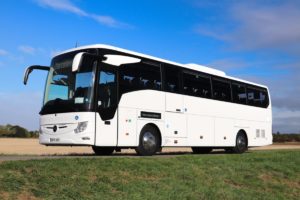
For example, you only get non-reclining TSE seats trimmed in fabric. You can’t have the Softline, Luxline or piping trim options and neither is the Mercedes-Benz logo within the seatback available. You don’t get lateral seat adjustment, footrests or fold-down trays on the seatbacks, but you do get luggage nets, three-point belts, and swiveling aisle-side armrests.
Other deletions from the Premium specification are double-tinted grey side windows, LED daytime driving lights, external periphery lights linked to reverse gear selection, upgraded decency screens, handles on the storage locker flaps, front door step-edge lighting, a storage compartment above the toilet, a multi-purpose area with blind at the centre door, a leather-trimmed steering wheel, LCD video monitors at the front and centre, LED aisle lighting and an additional (dummy) engine grille on the left of the coach rear. There are no side-window curtains or blinds, and steel wheels with hubcaps replace the Durabright alloy wheels usually fitted.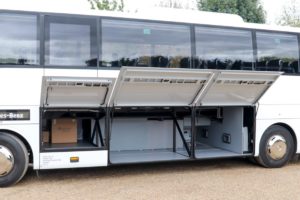
If this sounds a lot less, I was quite surprised at how much was left. You still get all the cab equipment including the Coach Multimedia audio video systems (though no screens), cameras at the centre door and rear (with wash system), the heated driving seat and Bluetooth hands-free equipment. The air conditioning system remains, as do the manual roof hatches, central locking system for the lockers, the dash mounted fridge and the stone guard foil protecting the lower section of the front screen. The coach we tested had a wood effect finish to the floor and I believe this is standard.
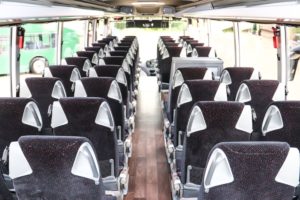 Daimler has always sought to be at the forefront of safety systems and these are all retained with the exception of the fire detection and suppression system.
Daimler has always sought to be at the forefront of safety systems and these are all retained with the exception of the fire detection and suppression system.
Normally you can specify a Tourismo to your heart’s content but you can’t with the Tourismo Access. You can choose whether or not to have a toilet, whether or not to have curtains, you can specify a carpet and you can select the interior trim and the exterior livery but you can’t specify anything else.
Very much not up for discussion is the driveline and it is here that much of the saving has been made. You get the 260kW, 348.66bhp OM936 7.7-litre engine in conjunction with the GO250-8 eight-speed Powershift 3 automated manual transmission. It is a step down from the 290kW, 389bhp of the 10.7-litre OM470 unit, and there is no fully automatic option, but 350hp/1,400Nm is still a respectable amount of power.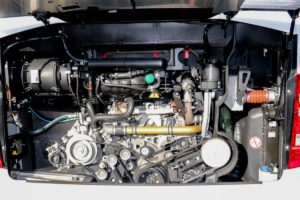
Mercedes-Benz offers two, two-axle versions of the Tourismo Access, the 12.3m we looked at and the longer wheelbase 13.1m variant, which increases the passenger capacity to 59 in straight seated versions. The specification can be mirrored across the Tourismo range if required. All Access models are newly built at the plant at Hosdere near Istanbul rather than conversions of existing stock. To date, more than 20 Tourismo Access coaches have been ordered, the first to be delivered being a 12.3m example, like the one tested, which is being operated by Paul’s of Stoke. There is a limited amount of stock available to order for delivery early in 2022.
As an introductory deal valid until 1 November, a five-year lease deal was being offered through Mercedes-Benz Finance at £2,207 per month based on 60,000km annually, although there was no option to buy at the end.
On the support side, in addition to the Coventry workshops, there are over 30 EvoBus Service partners in the UK along with seven mobile technicians with fully equipped vans backed up by a technical team in Coventry and three key account managers.
Exterior
Readers will be very familiar with the body style and shape of the Tourismo, so I won’t bore you with a general description.
The changes include a Hanover destination display which does impair the passenger view forward a little but most other PSVAR compliant coaches will suffer in the same way. In contrast, the mouldings surrounding the side door are less obvious and intrusive than on some other coaches we have tested. The glazing is single rather than double tinted, something I prefer, though I accept that for some this might be an argument in favour of specifying curtains.
Externally, only the steel wheels, hubcaps and single rear grille give away that the Access is a budget version of the Tourismo, and I doubt any passenger will notice the difference. The top hinged, manually operated locker doors open to reveal a large central hold with relatively little intrusion from the lift cassette within the first bay. Yes, you can see that there is a door in the side if you look, but it does not spoil the lines of the coach. The same is not true of the destination display at the side which inevitably makes it look more bus-like, but that is what the Government wants and all PSVAR coaches suffer in the same way.
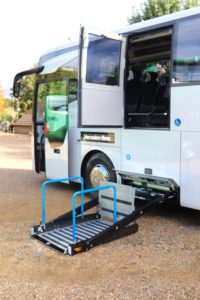 The ability to carry passengers who are in wheelchairs or who can’t climb the stairs is the reason the Access exists so I thought we had better have a go at deploying the equipment. To be truthful we had a few issues to begin with but as I suspect that we were the first to use it since it had been certified this probably wasn’t surprising. Our main difficulty was with a microswitch that prevented us deploying the ramp and once we had overcome this, it was relatively straightforward. It only goes to show the importance of training staff thoroughly beforehand.
The ability to carry passengers who are in wheelchairs or who can’t climb the stairs is the reason the Access exists so I thought we had better have a go at deploying the equipment. To be truthful we had a few issues to begin with but as I suspect that we were the first to use it since it had been certified this probably wasn’t surprising. Our main difficulty was with a microswitch that prevented us deploying the ramp and once we had overcome this, it was relatively straightforward. It only goes to show the importance of training staff thoroughly beforehand.
Interior
The first thing going for it in the eyes of passengers is the three pointed star sitting in the centre of the front grille.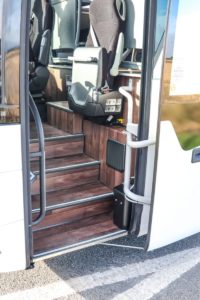
The entrance looks attractive with useful handrails and wood effect flooring. Four steps take you from the ground to the platform and a further two to the sunken aisle. The look from the front is an attractive one, the colours are coordinated and the seats look inviting. I found them comfortable too and on a journey would welcome knowing the person in front could not lean back into ‘my’ space. My only reservation was the small coat hook on the aisle side of the seat, beneath the handhold, that looked likely to catch on items of clothing as people brushed past on their way up and particularly down the aisle.
The wheelchair lift is useless without making space for the wheelchair, and the Access does this without having to remove them. They simply slide together. Driving on the day was John Wright, part of the family that ran Morley’s of Whittlesey, who had to get down on his knees to pull out the pin to release the red levers on both legs of the track-mounted seats by the side door, enabling them to slide along. To begin with he had used a screwdriver to remove the tracking inserts.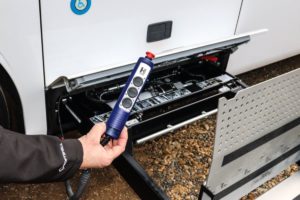
Once they have been released and the squabs tilted back, the seats can be slid forward against the seats in front and backwards against the seat behind to create the wheelchair bay. This method is quite clever, because it means that the difficult job of physically removing seats from the interior is avoided, but it does mean that you lose eight seats; a hefty chunk. If the seats are fully removed the loss is reduced to six places.
The lift unit is by Hubner and has a capacity of 300kg. To deploy it you begin by opening the lower bodyside flap and taking out the controller on its wander-lead and clicking the red handle two clicks. You then press the down button on the controller to deploy it to its full extent. With the cassette deployed the handrails can be manually folded up along with the ramp. You then open the side door and bring the platform up to the aperture by pressing the up button. When it reaches the top the lip plate deploys itself.
Be warned, at full extension the lift protrudes 2.1m from the side of the coach so you will not only need that space but also sufficient room to maneuver a wheelchair off the platform before you can safely deploy it. Even when the platform is next to the door aperture it protrudes 1.5m.
One the road
In a break from our usual practise, we asked several drivers for their views of the Access out on the road….and the opinion of an engineer and operator.
John Wright usually pilots the immaculate 2017 Volvo B8R Plaxton Leopard that is currently Fowler’s newest coach. His view was that, “It’s a bit slow away, even with your foot to the floor, but I can’t really fault it apart from that.”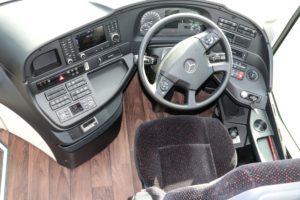
He thought his B8R was a bit quicker off the mark than the Access but the ride quality was on a par: “Everything it does, it does very well, the brakes are good and it’s very, very easy to drive,’ he said, adding: “I like the dashboard. There are lots of cubby holes for your phone and things, as well as lots of lighting options. You can pair your phone with the sat nav and use it with the microphone.”
He thought the moveable seating system was a good one, and much better than having to physically remove the seats. Likewise the mirrors: “You can see the whole of the front and all the corners if you are backing into a tight space.” He felt adults would complain about the lack of curtains saying: “If the sun is shining on one side of the coach all day, you really need them.”
Nic Shields, who has been driving coaches for Fowlers for 12 years and usually drives the last B12M ever built, had taken the vehicle to Manchester and back on a private hire on the day before our evaluation. He was very positive about the experience, although arriving at his destination to find one of the hub caps missing was a surprise to him.
‘It is nice to drive; a totally different ball game to the Volvos. It is not as powerful off the line as I am used to and struggles a little on hills, but it is comfortable and rides well. Comparing it with the B7R Profiles that Fowler’s operate, he thought pulling away from a junction was perhaps slightly quicker in the Tourismo and he liked having the gearbox control on a stalk rather than the stick that some Mercedes-Benz’ were equipped with in the past.
“I did enjoy driving it and I felt comfortable doing so, more comfortable than in earlier Mercedes-Benz coaches I have driven. The dash is very ergonomic for the driver. You can easily get to all the controls, including the satellite navigation system and the heater, without having to reach a long way,” he said. Something he picked out for praise was the steering, saying: “It turns well and has a particularly good lock.
“Passengers like the ride; the only drawback is that they are looking at the Hanover system rather than the view.” Although use of the lift was demonstrated to him by James Kay of EvoBus when he delivered the coach he had no need to deploy it on the trip, though he did question the practicality of losing eight seats. Even taking into account the space taken up by the lift, Nick still felt there was plenty of luggage space.
He returned a very creditable 11.8mpg with the coach on the Manchester trip of 362 miles (583km) with 35 passengers on board. Nobody complained about the absence of curtains, but with the sun on one side of the coach on the journey north, he felt that fitting them would have been an advantage.
A further view on the performance was given by Chris Shaw, Dew’s Coaches Operations Manager: “I’m a bit surprised how well it goes. The initial get-up-and-go isn’t quite there; when you first put your foot down it hesitates, but after that it’s quite responsive,” he said. “The retarder works very well too. This version of Powershift is better than the old one which didn’t know which gear it wanted to be in.”
Like the others, Chris felt it needed curtains but thought that, for the market it was aimed at, it was very good. His colleague, Tony, said:
“From a driver’s perspective, it’s not very different at all. The ride is smooth and comfortable, especially bearing in mind the Fenland roads. The seats show every single speck of dust. For what you would use it for, kids and rail replacement, it’s fine, but it’s not for tours.” Both Chris and Tony criticised the electric front sun blinds, that ‘make sure passengers see nothing ahead.’
Speaking afterwards to EvoBus about the pull away issue, they pointed out that it is possible to change the software settings on the gearbox dependent upon the operation which can improve the acceleration speed.
Mechanics view
Tom Williams is Chief Engineer with Dew’s Coaches at Somersham. Dew’s are confirmed Tourismo enthusiasts with several in the fleet, the latest of them placed in service last year.
Tom was full of praise for them: “They’re nice vehicles. We get very few problems with them. If we need more help we tend to go to EvoBus at Coventry rather than the local dealer.”
He looked over the coach and although he was generally impressed with what he saw, did identify a few areas that disappointed him on the Access. Perhaps the most serious of these was the lower edge of the door through which the lift disgorges its passenger into the interior.
Unloading the ramp requires the driver to bend down in order to raise the safety rails and standing up afterwards, it is very easy to bump your head on the scalp-splitting corner of the open door. Tom would like to see some kind of padding protection added in this area and I could only agree with him.
All of Dew’s Tourismos have the bigger OM470 engine and looking at the OM936 installation he disliked the fact that the fuel filter and pre-filter were not immediately accessible: “You shouldn’t have to do filters through a hatch on the inside of the coach.” He also noted condensation in the nearside rear light unit, which he felt was poor on a new coach.
With the steel wheels come polished hubcaps which Tom has found vulnerable in use. He doesn’t like them either because they discourage driver’s from checking their wheels properly. A criticism carried over from other Tourismos was that the lower securing for the mesh within the grille at the rear of the offside was, ‘not substantial enough to withstand Fenland winds,’ causing it to vibrate.
Another positive he mentioned was that, ‘most parts ordering is web-based now. You know the availability and how much it is going to cost when you order. It’s very good.’
Operator view
Giving his thoughts on the coach, Andrew Fowler said: “It is something totally different for me to look at but I’m thinking of the long term and I’m quietly confident that Mercedes-Benz will still be here.
“It’s a modern, attractive, practical-looking coach. To me, it looks a functional, straightforward thing. I like it and I like the price. Delivery times are good too. I have no experience of them, but people I trust speak very highly of them. I was very impressed with the delivery of a replacement wheel trim; it took less than 24 hours.”
Andrew added: “It’s not a touring coach by any means, but it would do a tour.” He felt there was nothing that had been deleted from the standard specification that he could not live without, though if he bought one he might well replace the steel rims with alloys. Although his drivers felt curtains were needed, he was not convinced, saying: “They only get abused by passengers. They come back in tied in knots or covered in chewing gum. You don’t have curtains in your car.”
He shared concern about the front destination display obscuring the view out and wondered whether it could not be mounted on a hinged system to enable it to be folded out of the way when employed on work not requiring it.
Verdict
The backbone of nearly every private operator’s fleet was once Bedfords or Fords with 53-seat Plaxton or Duple bodies.
Passenger expectations have risen a long way in the interim but I don’t think many people would think other than positively of a Tourismo Access turning up to transport them today, especially if you added a little to the basic purchase cost by specifying curtains and a monitor. The Tourismo Access ticks every box and represents an awful lot of coach for the money.
This is a coach you can use now and cascade later. Whether it is truly future-proof remains to be seen; people thought they were doing the right thing when they bought Euro V but have found their purchases legislationally obsolete before they have been financially written off, so the answer must be that it meets all current needs, which is about as much as you can hope for.
SPECIFICATION |
|
Mercedes-Benz Tourismo Access 12.3m |
|
|
Dimensions |
|
|
Length |
12.295m |
|
Width |
2.53m |
|
Height |
3.645m |
|
Wheelbase |
6.09m |
|
Front overhang |
2.89m |
|
Rear overhang |
3.315m |
|
Min turning circle |
21.276m |
|
Fuel tank capacity |
480-litres |
|
AdBlue capacity |
40-litres |
|
GVW (max permissible) |
19,500kg |
|
ULW |
13,214kg |
|
Engine/transmission |
|
|
Engine |
Mercedes-Benz OM936 EuroVI. 7.7-litre, six-cylinder unit |
|
Power |
260kW/350hp at 2,200rpm |
|
Torque |
1,400Nm at 1,200-1,600rpm. |
|
Gearbox |
Mercedes-Benz GO-250 Powershift 3 automated manual |
|
Rear axle |
Mercedes-Benz RO440. |
|
Front axle |
ZF independent. |
|
Brakes |
Active Brake Assist 4, ABS, ASR, SWR, BAS, DBL and EBS. |
|
Steering |
ZF8098 Servocom |
